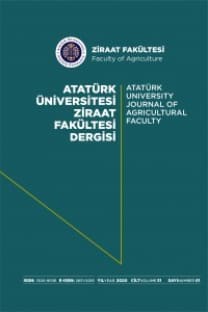ERZURUM KARS VE AĞRI İLLERİNDE Q HUMMASI ÜZERİNDE ÇALIŞMALAR
ÖZETBu çalışmada Erzurum, Kars ve Ağrı illerini içine alan bölgede,insan, -koyun ve sığır serumlarında Q humması antikor durumu ve buhastalığın insan ve hayvanlar arasında muhtemel yayılma yolları incelenmiştir.Bunun için ·semınlar mikroaglutinasyon metodu ile serolojiktestlere tabi tutularak, antikor titreIeri tetkik edilmiştir.Koyun ve sığır serumlarının bir kısmı mikroaglutinasyon, kapilartüp aglutinasyonu ve kompleman fik:zasyon metodları ile ayrı ayrımuayene edilerek; alınan sonuçlar karşılaştınlmıştır.Sewlojik testlerde pozitif sonuç veren bazı, koyun ve sığır senıınlarıkaboylara intraperitonal enjekte edilerek hastalığın etkeni olan Cox.iellaburnetii'nin izolasyonuna çalışılmıştır.Ayrıca çalışma bölgesinde altı belirli yerde, koyunlardan top~lanan Dermoserıtor cinsi kenelerden Coxiel/a burnetii'nin izole edilmesidenenmiştir.Oç ilden toplam olarak 456 koyun ve 262 sığır senımu incelenmi~tir.Koyun serumlarının %22, i inde, sığır serumlarının % 15,6 sındaQ humması antikoruna raslanılmıştır. İncelenen 178 insan serumundaise %11,2 oramnda Qbumması pozitif sonuç bulunmuştur.Deneme hayvanlarına enjekte edilen Q humması antikonı taşıyanserum1ardan, etken izolasyonu mümkün olmamıştır. Ancak, kene1er~den Coxiella burnetii aynımıştır.SUMMARYSTUDİES ON Q FEVER İN HUMAN, SHEEP AND CATILE INERZURUM, KARS AND AGRI PROVINCESA research was conducted to investigate the ex.istance of Q fever antibodiesin human, sheep and cattle serums'by microagg1utination tests, and probaNemodes of transmission amonghumen and livestock in Erzurum, Karsand Ağrı provinces, in Eastem Turkey.In all the tests microagglutinationmetbodwas used as standart, in additiontwo other methods namely, capilrary. tube agglutination and complemantfixation were a1so used for some of theserums, and three methods were comparedwitb one another.In oder to isoIate the microorganism .(C.burnetii), some sheep and cattleserums which yielded positive in serologicaltests, were inoc.ulated to guinea pigsintraperitoneally.In addition to these for the purposeof isolation of C. burnetii, some ticksbe10nging to Dermocentor genus weretaken from the sheep, reprasenting thesix localities in the region. These tickswere inoculated into guinea pigs intraperİtoneally,The anİmal serums were collectedfrom Meat and Fish Company, andthe Municipal Slougbterhouse of Erzurum,The human serums were obtainedfrom Biöchemical Laboratories ofErzurum Numune HospitaI. The antİgensused for the sorological reactionswere supplied by Instiutude Pasteur ofFrance.209 sheep and 108 cattle serums,representing Erzurum area, were examİnedand among thern 50 e{23,4) sheepand 13 (% 12,0) cattle serums were foundto have Q fever amibodies. 30 (%20,7)out of 146 sheep serums and 18 (%17, i)out of 105 cattle serums from Karsarea gave posİtive results of Q fever.21 (%20,6) out of 102 sheep and alsoLO (%20,4) out of 49 cattle serums werefound to be positivc from Ağrı province.Of the total 456 sheep and 262 cettleserums from the three provinces weretested, and in ım (%22,1) sheep and 41(%15,6) cattle serums, Q fever was ob servedas positive. 178 human serums alsowere tested and 20 (% 11,2) out of themwere found to carry Qfever antibodies.In order to compare the three differentsero10gical methods, 204 sheepand cattle serums were examined andthe results are as fol1ows: 39 (%19,1)serums positive with microagglutin ation,34 (%16,7) and 36 (%17,6) serums positivewith capillary tube agglutinationand complament fixation ınethods recpectively.On the isolation of C. hurnetii,38 sheep and cattle serums containingQ fever antbodies were injected into guineapigs intraperitoneally. No clinicalsymptoms appeared in these animalsduring the first one month of the inoculation,but serological tests which weremade 30 days later, indicated posttivereactions at the high level in the threeguinea pigs. However the microscobicexaıninations failed to show the microorganismsin the blood samples of theanimals.For iso1ating the agent, suspcnsionsfrom Dermocentor ticks were injectedinto guinea pigs. During the first monthof injections, the animals showed noclinical symptoms, but serologicaltests gave positive results in one guineapig. The smears prepared from the bloodand spleen of this animal showed rickettsia.T,he rickettsia taken from the bloodand s~leen of the animal we,:e isolatedin the yolk-sac cu1tures.In addition, social and geographica1condit ons of the region were discussedas factors effecting the transmİssion ofQ fever.
